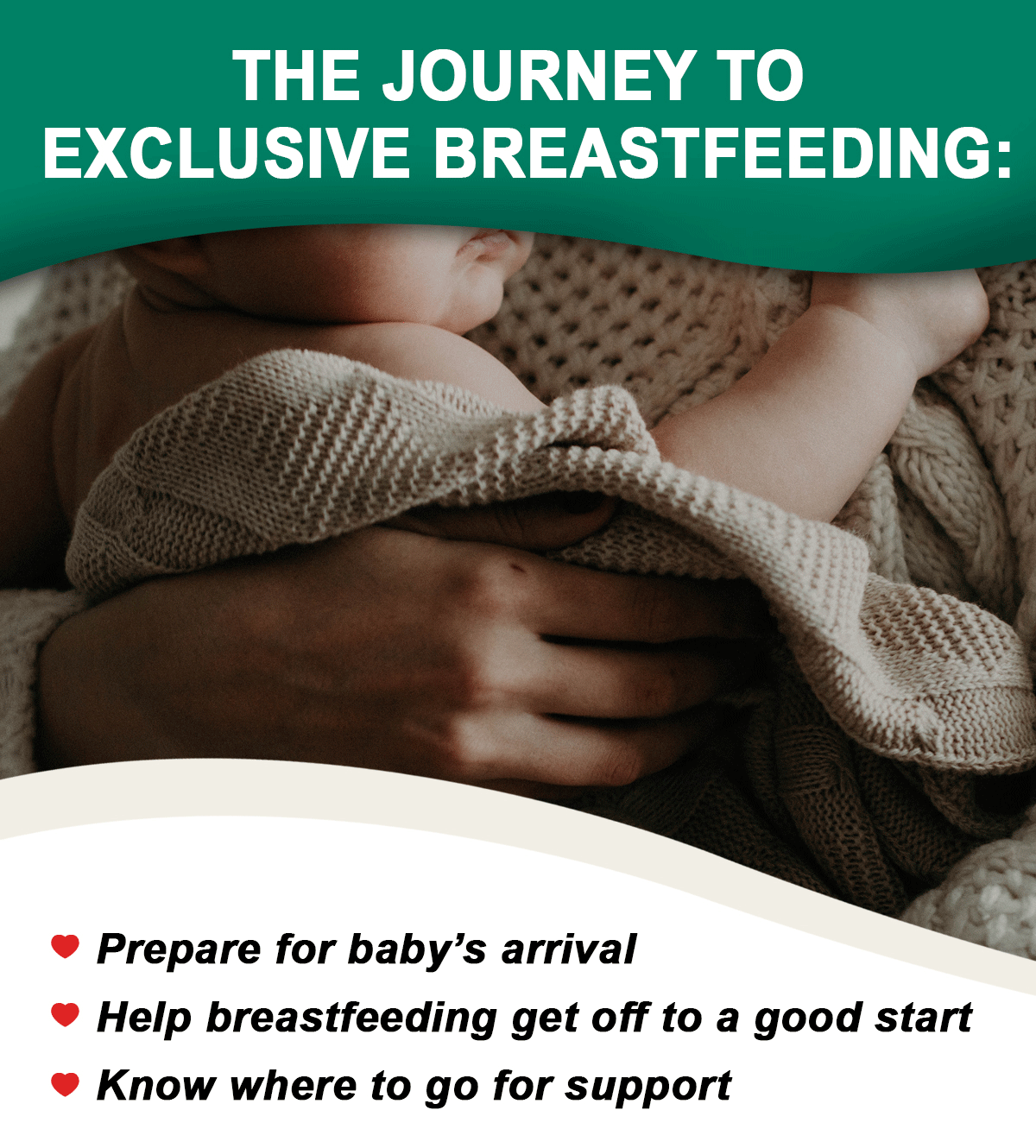Breastfeeding
Breastfeeding is the biologically natural way to provide infants with the nutrition they need for healthy growth and development. Health Canada recommends breastfeeding exclusively (giving only breastmilk) for the first six months, with continued breastfeeding for up to two years and beyond.
The Journey to Exclusive Breastfeeding
Prepare for baby’s arrival:
Learn why breastfeeding is important
- Breastfeeding is important for the nutrition, immunity, growth, and development of infants and toddlers.
- Exclusive breastfeeding (giving only breastmilk) is recommended for the first six months, with continued breastfeeding along with solid foods up to two years and beyond.
Learn how breastfeeding works and about normal newborn behaviour
- Like growing a baby during pregnancy, women’s bodies are made to feed their baby when they are born.
- It can take the first month or more for breastfeeding to be well established. This period allows both mom and baby time to learn and settle in to breastfeeding.
- To build your breastfeeding confidence, read and explore videos on latch and positioning, how to make sure baby is getting enough, feeding cues, and common breastfeeding concerns.
- Understanding normal newborn behaviour will also help you anticipate things such as growth spurts, cluster feeding, and baby’s second night.
- You can register for MLHU’s FREE Online Prenatal Education Program or explore the Prenatal eManual.
Help breastfeeding get off to a good start:
Feed as soon as possible after birth
- It is important that you start breastfeeding as soon as you are able to after the birth of your baby. Babies often show signs of wanting to feed and will attach and suck at the breast in that first hour or two. Feeding soon after birth triggers mom’s body to produce the milk baby needs in the weeks to come.
- Colostrum (first milk) is packed with nutrients and antibodies. It is easy to digest, and gives baby a strong immune boost, helping to protect against infections and diseases.
Provide early skin-to-skin contact
- Immediate and uninterrupted skin-to-skin for the first hour after birth provides the best foundation for your breastfeeding relationship.
- Skin-to-skin is the healthiest place for a baby because it helps them adjust to life outside the womb. They have better blood sugar levels and heart rate, and are exposed to good bacteria on your skin.
- Baby can smell you, hear you, feel you, and get to know you when they are held on your bare chest with only a diaper on.
- Skin-to-skin babies stay warmer (since their bodies can’t regulate temperature quite yet), are calmer, and breastfeed better than babies who are wrapped up or swaddled.
Feed frequently
- Babies need to feed at least 8 times in a 24-hour period as their stomach size is very small and breastmilk is easily digested.
- Frequent feeding, through the day and night, supports baby’s rapid growth in the early days and months. When baby feeds at night when mom’s prolactin levels are higher, it helps her produce more milk.
- Early, frequent feeding also prompts mother’s body to make enough breastmilk. The more frequently a baby feeds at the breast, the more milk mom will make.
- Breastfeeding at night in the early weeks and months ensures babies get all the nutrition they need to grow and it helps mom produce more milk. When babies are responded to early, it builds a secure attachment.
Keep your baby close (share a room together)
- Staying close to baby helps mom to learn and respond to feeding cues.
- Babies feed better when they are offered the breast after showing early cues such as stirring, mouth opening, rooting, and turning towards the breast. Crying is a late cue and makes learning to breastfeed challenging.
Learn hand expression (give breastmilk if supplements are needed)
- Expressing your breastmilk by hand is the most effective way to express colostrum (early milk).
- If needed, expressed colostrum can be given to baby if they need extra food.
Know where to go for support:
- Website information and resources.
- Telephone support from a public health nurse.
- Breastfeeding home visits for families with infants under six weeks of age who are experiencing breastfeeding challenges.
Date of creation: February 7, 2013
Last modified on: June 11, 2024
Last modified on: June 11, 2024
References
1Health Canada. (2023). Nutrition for healthy term infants: Recommendations from birth to six months. Retrieved from
https://www.canada.ca/en/health-canada/services/canada-food-guide/resources/nutrition-healthy-term-infants/nutrition-healthy-term-infants-recommendations-birth-six-months.html
https://www.canada.ca/en/health-canada/services/canada-food-guide/resources/nutrition-healthy-term-infants/nutrition-healthy-term-infants-recommendations-birth-six-months.html
2World Health Organization. (2018). Protecting, promoting and supporting Breastfeeding in facilities providing maternity and newborn services: the revised BABY-FRIENDLY HOSPITAL INITIATIVE. Retrieved from
https://breastfeedingcanada.ca/wp-content/uploads/2020/03/WHOUNICEF-bfhi-implementation-2018-En.pdf
https://breastfeedingcanada.ca/wp-content/uploads/2020/03/WHOUNICEF-bfhi-implementation-2018-En.pdf
3National Library of Medicine. (2019). Skin‐to‐skin contact the first hour after birth, underlying implications and clinical practice. Retrieved from
https://www.ncbi.nlm.nih.gov/pmc/articles/PMC6949952/
https://www.ncbi.nlm.nih.gov/pmc/articles/PMC6949952/



